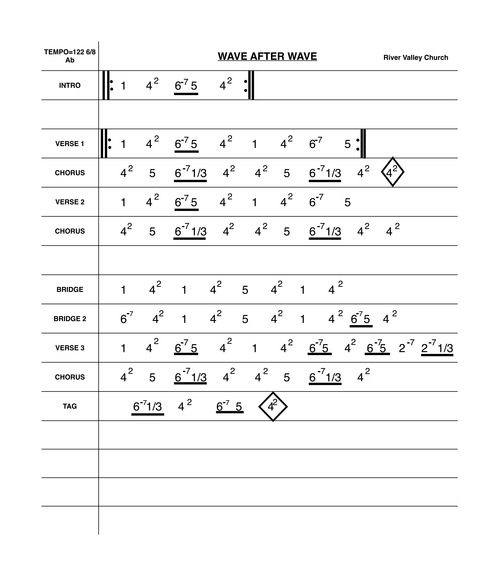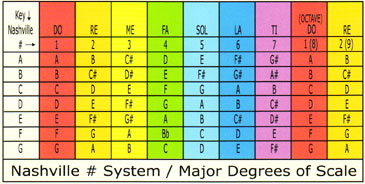

- Nashville number system chart black and white cracked#
- Nashville number system chart black and white series#
You are right - and, in fact, there are about as many ways to write number charts as there are people who write them.
Nashville number system chart black and white cracked#
The first time i heard it called the "Nashville number system" I cracked up. 1 is root 2 is the 2nd tone in the scale and so on. I learned that in mid school in 1960 in a classical orchestra class. Except it always amazes me at the audacity of Nashville to call it the "Nashville number system". So, as in your example in the Key of C, if we have a progression that goes C Amin, F, G, the Dmin, G, and back to C, we could write it this way:Īs a side-bar, I have been on studio gigs where the charts are in regular letters, using upper and lower case letters for Major and Minor.so our example above in the key of, say G for example would look:Īgain, your thread was excellent without my input.hope I just made a small contrubution to your otherwise perfect explanation. Out side of the "Nashville" Number System, the much of the music industry (& music educators) used Roman Numerals in the Number system where upper case characters/capital letters represent major chords and lower case/small letters represent minor chords. Without taking anything away from you thread, I'd like to take the liberty of adding a small comment. Study the chart below, and you will see how the numbers at the top of the chart can represent any progression in any key. Since you have charted the song using numbers, the band can play it in your key very easily, because 1, 4, 5, 1 now means Eb, Ab, Bb, Eb – because in the key of Eb, the “1” chord is Eb, the “4” chord is Ab, and the “5” chord is Bb. Now, you sit in with a band that has always played the same song in C and does not know the chord progression in your key. Let’s say for example that you always play a certain song in Eb, but you have charted the song using the number system. By using the number system and writing the progression as 1, 4, 5, 1, and anyone who is familiar with the Nashville Number System can play the correct progression in any key. That would be fine if we never wanted to play the song in any key except C. Now, you may wonder why not just call the chards what they are – C, F, G, C. For example, if the progression of chords for a particular song is C chord, F chord, G chord then back to C chord, we can say the progression is 1, 4, 5, 1.


Nashville number system chart black and white series#
While this series of numbers represents the progression of NOTES within a scale, we can use this same series of numbers to represent a progression of CHORDS. If we start on the root note (C) and number the notes, we will have C=1 D=2 E=3 F=4 G=5 A=6 B=7 and (back to the root note) C=8. As an example, in the key of C the C note is the root and the scale is C D E F G A B C. The diatonic scale is the normal musical scale made up of five whole tones and two half tones – e.g. The diatonic scale is used as the basis for the numbers. Numbers are used to represent chords in a progression. I, myself, just learned how these charts work a few months ago when I found Number Charts to be an absolute necessity when playing steel guitar shows with musicians who may not be familiar with the songs I play at these shows. When I was active in music many years ago, this kind of chart was unheard of. And, if you have further questions, or if you want a sample chart, or if you find errors in the chart I am including below, please email me. If you already know the Nashville Number System, ignore this thread. I thought it might be helpful to some of you who are not familiar with the “Nashville Number System” if I posted a little information about it. Since then I have received several emails asking about Number Charts. Your profile | join | preferences | help | searchĪ few days ago John Bresler posted a thread that asked for the chord progression to “I Can’t Stop Loving You,” I answered, informing John I was sending him a Number Chart on the song. Classic country shuffle styles for Band-in-a-Box, by BIAB guru Jim Baron.


 0 kommentar(er)
0 kommentar(er)
